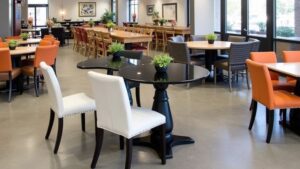Round dining tables save space by enhancing spatial efficiency in compact areas. Their circular shape allows for flexible seating arrangements, accommodating various numbers of guests without designated “head” seats. This design promotes closer chair placement, reducing clutter and maximizing accessibility. Additionally, the absence of corners fosters social interaction and engagement. While ideal for smaller living spaces, certain limitations exist. Discover more about the advantages and considerations of round dining tables for your home.
Key Takeaways
- Round tables occupy less floor space than rectangular tables while maintaining similar seating capacities, enhancing spatial efficiency in compact areas.
- The absence of corners reduces visual clutter, creating a more open atmosphere and improving overall space utilization.
- Pedestal bases allow for better legroom, enabling closer chair arrangement and optimizing usage in tight spaces or awkward corners.
- The adaptability of seating at round tables promotes flexibility for varying guest numbers without designated “head” seats, maximizing seating arrangements.
- Their shape enhances movement and accessibility, facilitating smoother traffic flow around the dining area compared to traditional rectangular tables.
Space Efficiency of Round Tables
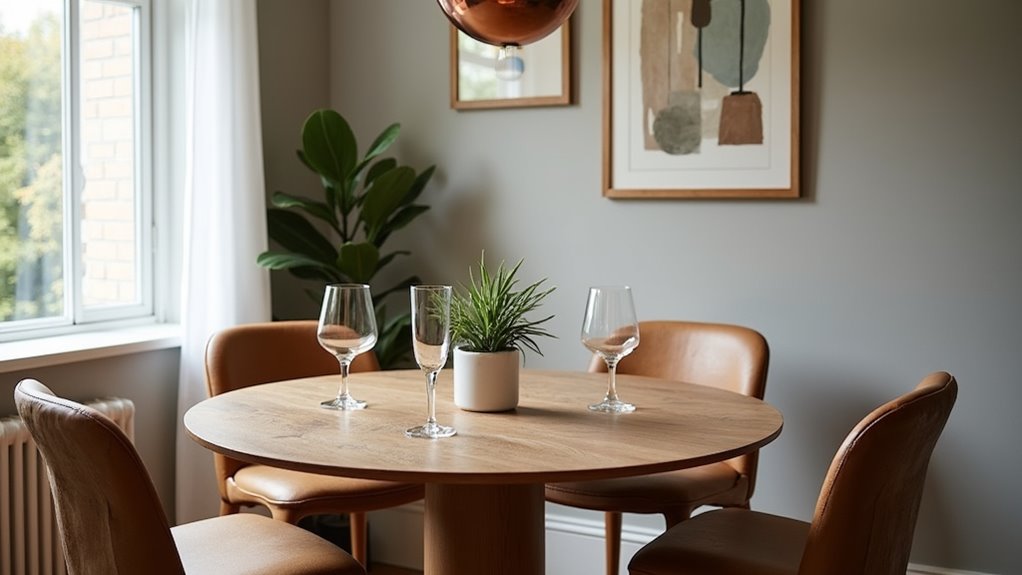
Although space constraints often challenge dining arrangements, round tables emerge as a practical solution, enhancing spatial efficiency in compact areas.
With smaller surface areas than rectangular counterparts, round tables accommodate similar seating capacities while occupying less floor space. Their absence of corners reduces visual clutter, facilitating a more open and inviting atmosphere. Round tables encourage better movement due to their shape, which allows for flexible seating arrangements around them. Their design is optimal for small dining rooms, which benefit from having a round table’s portability and adaptability. Additionally, round extendable dining tables can expand from 45.7 cm to nearly 3 meters, making them versatile for various gatherings.
Commonly featuring pedestal bases, these tables enhance legroom, allowing for closer chair placement without obstruction. Round table dimensions cater to the nuances of confined spaces, fitting easily into awkward corners and creating a compact dining footprint.
This design optimizes traffic flow and movement, allowing for unobstructed access, making them ideal for compact dining arrangements.
Ultimately, their versatility enriches spatial dynamics, balancing aesthetics with functionality.
Seating Flexibility in Compact Areas
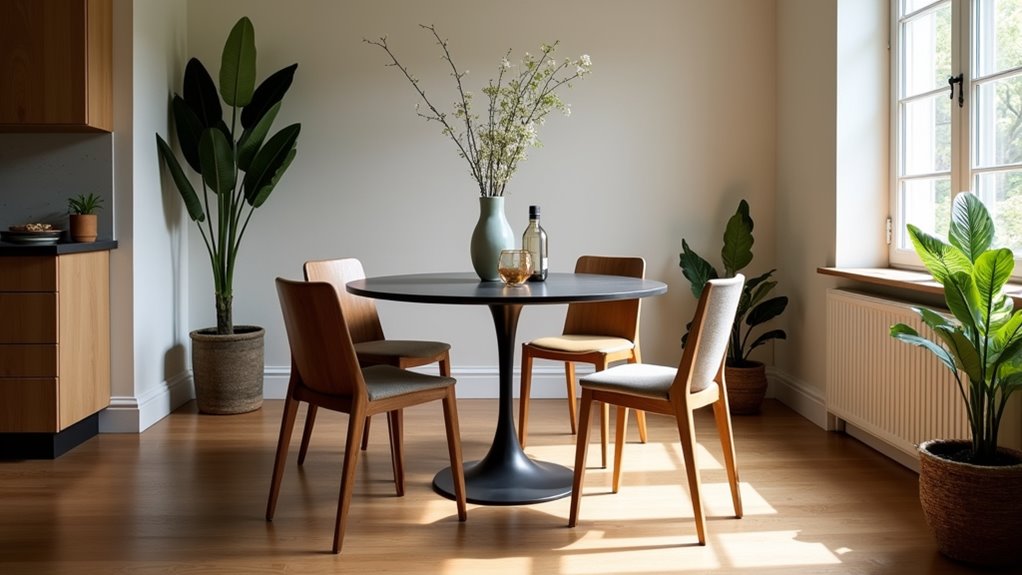
Round dining tables offer remarkable adaptability for seating in compact areas. Their design allows for efficient space utilization, accommodating varying numbers of guests without compromising comfort. Additionally, options like wall-mounted drop-leaf tables provide excellent space-saving solutions while maintaining versatility for different activities.
Adaptable Guest Accommodations
In compact living spaces, adaptable guest accommodations become essential for hosting and socializing. Round dining tables excel in providing seating flexibility, allowing hosts to accommodate varying guest counts without designating “head” seats. This equality fosters guest comfort, ensuring all participants enjoy intimate conversations during a dinner party.
The absence of corners enables additional chairs to blend seamlessly, enhancing space efficiency. With pedestal bases, legroom remains unobstructed, facilitating easy movement around the table.
Round tables integrate well with diverse seating options, such as stools and benches, further enhancing their adaptability in small areas. This versatility not only promotes enjoyable dining experiences but also transforms spaces efficiently, maximizing the use of available floor area for gatherings.
Efficient Space Utilization
When optimizing compact areas for dining, the strategic use of round tables enhances both seating flexibility and overall space efficiency. Their smaller footprint compared to rectangular tables allows for superior space optimization, enabling seamless integration with surrounding furniture arrangements.
The absence of corners contributes to greater accessibility and smoother movement in tight spaces, reducing physical barriers. Round tables accommodate odd-numbered seating without hierarchy, fostering shared interaction and social dynamics.
Pedestal bases offer optimal legroom, allowing chairs to be pushed closer, while mixed seating styles enhance versatility. This design minimizes clutter and enhances visual harmony, making round tables ideal for apartments or homes with limited dining space, ultimately maximizing every inch available for functional use.
Ideal for Small Apartments
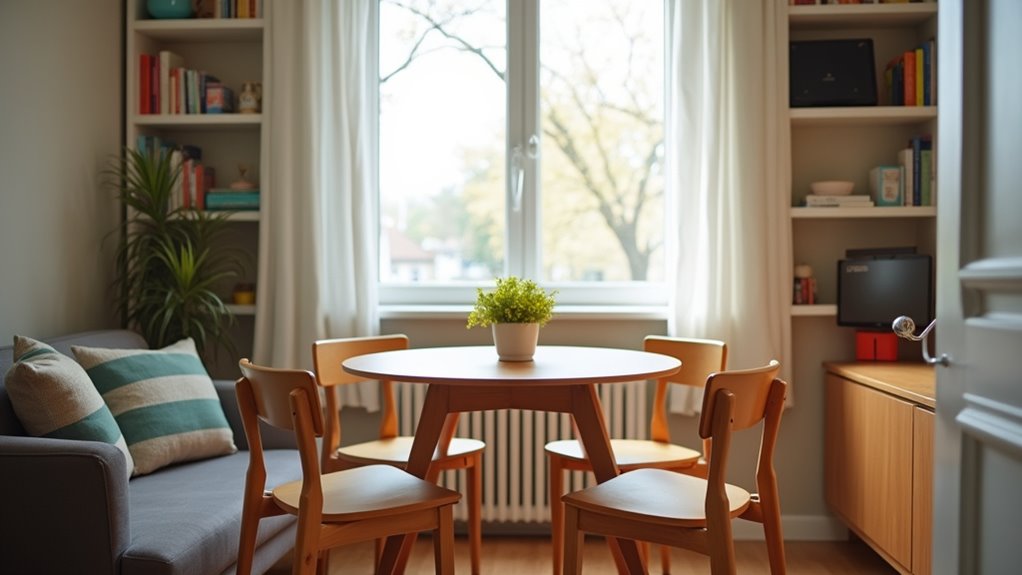
As small apartments often present challenges in terms of space management, round dining tables serve as a practical solution. Their design lacks corners, allowing for an efficient seating arrangement that maximizes space planning. The following characteristics highlight their suitability for compact living:
| Feature | Benefits | Functionality |
|---|---|---|
| Shape | No corners, easy to fit against walls | Maximizes usable surface area |
| Flexibility | Extendable options for guests | Adapts to varied spaces |
| Traffic Flow | Smooth edges enhance safety | Improves movement |
With these attributes, round tables considerably reduce spatial congestion and create a more open atmosphere, making them ideal for small apartments. Their functionality and aesthetic appeal ensure they complement any compact living environment. Additionally, many modern round dining tables feature eco-friendly materials that promote sustainability while enhancing the overall design.
Conversational and Social Benefits

Round dining tables enhance face-to-face interaction, promoting meaningful connections through improved eye contact and equal visibility.
Their shape cultivates an inclusive dining environment, allowing all participants to engage freely, regardless of their position at the table.
This arrangement fosters group engagement, making conversations more fluid and inviting.
Enhanced Face-to-Face Interaction
How might the design of a dining table influence the depth of conversation? Round tables enhance face dynamics by enabling direct eye contact among all participants, fostering a sense of equality in interaction styles.
This absence of hierarchy removes barriers, encouraging spontaneous glances and nonverbal cues, thereby enriching dialogue. The circular form creates a softer, more intimate setting that invites participation from every guest, reducing formality and promoting emotional connections.
As conversations flow seamlessly around the table, equality in engagement minimizes interruptions while amplifying inclusion. This geometry not only cultivates a welcoming ambiance but also supports those with hearing impairments, ensuring everyone is heard.
Ultimately, round tables significantly enhance the quality of face-to-face interaction in social gatherings.
Promotes Group Engagement
The design of round dining tables not only enhances face-to-face interactions but also significantly promotes group engagement. Their circular form is psychologically perceived as comforting, fostering community bonding and diminishing social barriers.
This layout encourages egalitarian interaction, as every participant enjoys equal visibility and access, eliminating dominance hierarchies. Studies demonstrate that round tables stimulate active involvement and deeper dialogues, particularly enhancing social dynamics in collaborative environments.
As individuals gather around, the shared space nurtures emotional connections, facilitating laughter and storytelling that further strengthen interpersonal trust. Consequently, round dining tables create a positive atmosphere for social exchanges, reinforcing relationships and encouraging cooperative behavior, making them an excellent choice for fostering engagement among group members.
Inclusive Dining Environment
While fostering an inclusive dining environment, round tables naturally enhance conversational dynamics and social interactions. Their design promotes shared values and community bonding through various features:
- Elimination of Hierarchy: Round tables lack a “head,” allowing all participants to feel equally valued and engaged.
- Facilitated Connection: The circular format encourages eye contact and conversation flow, breaking down social barriers and cliques.
- Comfort and Accessibility: By reducing physical hazards and accommodating diverse seating arrangements, they create a welcoming space for all.
This inclusive design cultivates a psychological sense of safety and belonging, allowing diners to relax and connect.
Ultimately, it enhances social interactions in any shared dining setting.
Design and Aesthetic Advantages
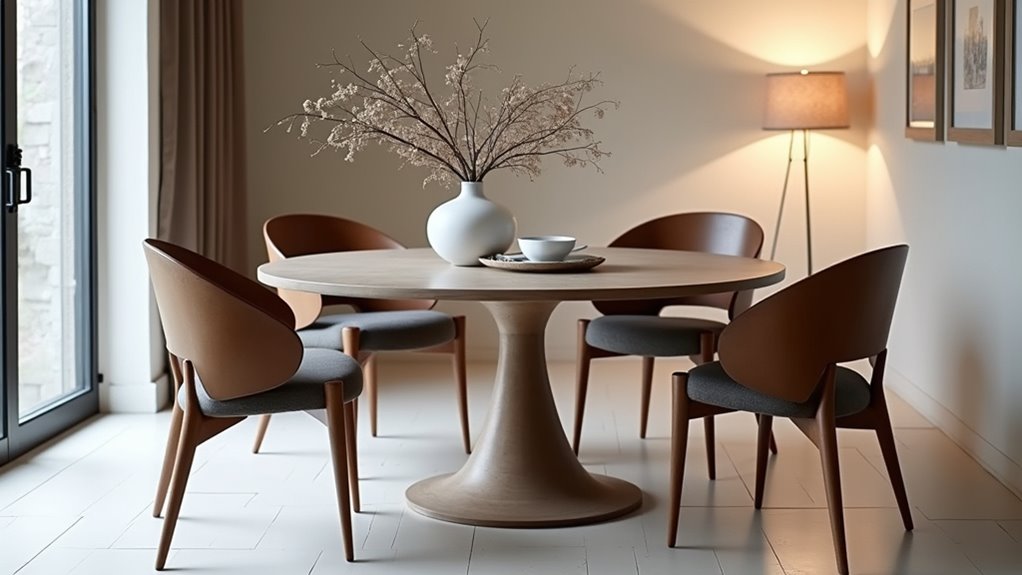
Round dining tables often enhance both design and aesthetics in various interiors, seamlessly blending functionality with visual appeal.
Round dining tables beautifully combine practicality with style, enriching spaces with their graceful design and inviting atmosphere.
Their design versatility allows them to fit effortlessly into diverse styles, from vintage to modern, making them a staple in many homes. The gentle curves of round tables create aesthetic harmony, softening the visual impact and contrasting with angular furniture.
This shape promotes a cozy ambiance, encouraging intimate dining experiences and seamless interaction among diners. Furthermore, round tables serve as a focal point in dining areas, allowing for creative lighting designs that enhance the overall setting.
Their capacity to accommodate various seating arrangements further underscores their practicality, merging style with efficiency in space utilization. Additionally, round tables can be complemented with solid hardwood dining tables, adding a touch of warmth and durability to the dining experience.
Limitations and Considerations

Although round dining tables offer significant design and aesthetic advantages, they also come with various limitations and considerations that can affect their practicality in different settings.
Key factors include:
- Seating Capacity Limitations: Round tables under 60 inches typically seat six adults comfortably, while larger versions may complicate access to central dishes.
- Spatial and Room Layout Constraints: In narrow spaces, round tables can lead to poor flow and unused corners, requiring a minimum clearance of 36 inches for movement.
- Stability and Structural Concerns: Larger tables on pedestal bases may wobble without proper engineering, and limited leg configurations restrict under-table storage.
These aspects highlight the space limitations and structural concerns inherent in round dining tables, impacting their versatility and functionality.
Articles on the same topic:
-
Top 10 Dining Tables in Dubai for All Styles
-
7 Best Commercial Dining Tables and Chairs for Your Business
-
Top 3 Best Selling Dining Tables for 2025
-
Top 3 Brown Jordan Dining Tables for Your Outdoor Area
-
Top 3 Lexington Furniture Dining Tables for Your Home
-
7 Stunning Rustic Log Dining Room Tables for Your Home



